Fire Protection Methods for Structural Steel
VerifiedAdded on 2023/04/21
|9
|1426
|112
AI Summary
This research paper analyzes the fire protection methods that are commonly used in the Australian construction industry to protect structural steel members from fire exposure.
Contribute Materials
Your contribution can guide someone’s learning journey. Share your
documents today.
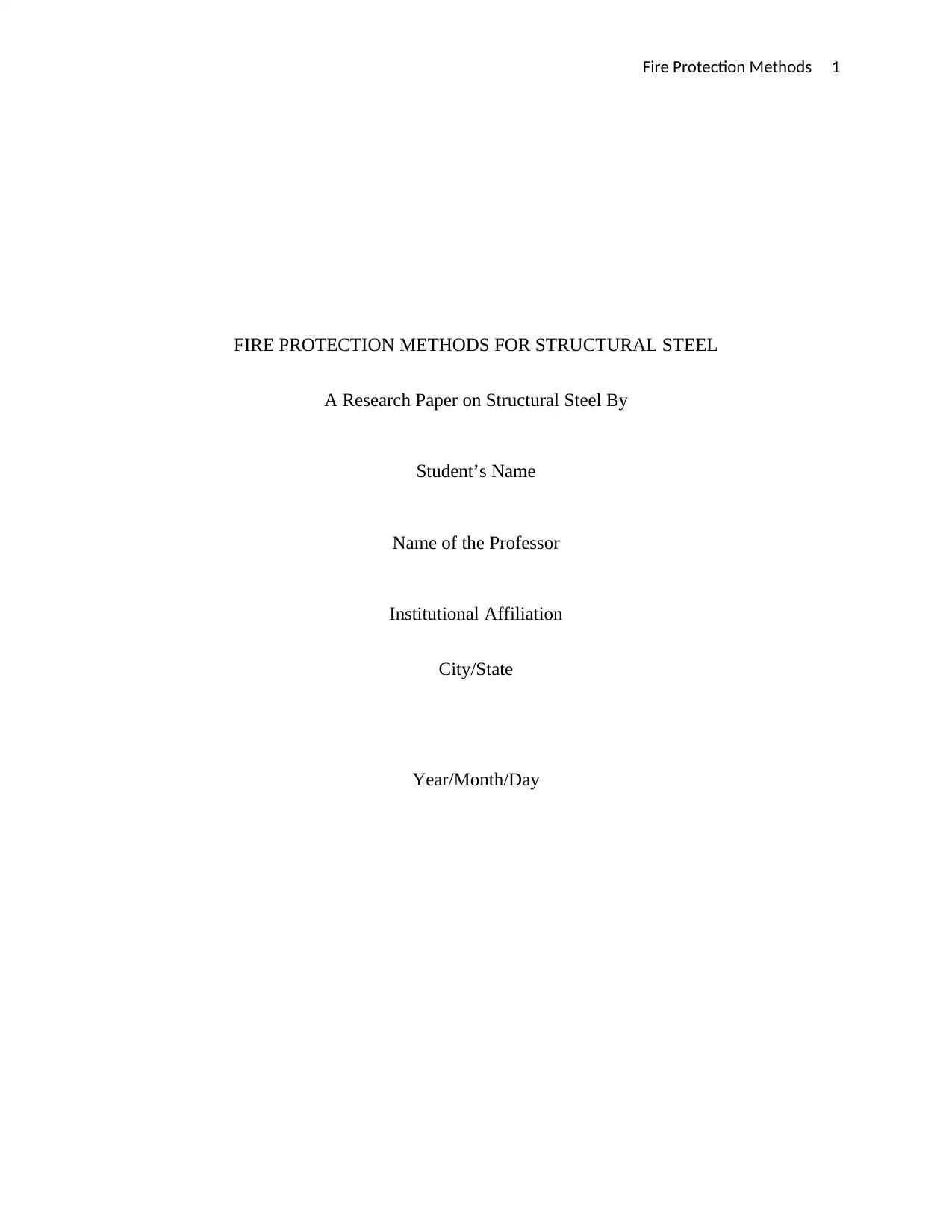
Fire Protection Methods 1
FIRE PROTECTION METHODS FOR STRUCTURAL STEEL
A Research Paper on Structural Steel By
Student’s Name
Name of the Professor
Institutional Affiliation
City/State
Year/Month/Day
FIRE PROTECTION METHODS FOR STRUCTURAL STEEL
A Research Paper on Structural Steel By
Student’s Name
Name of the Professor
Institutional Affiliation
City/State
Year/Month/Day
Secure Best Marks with AI Grader
Need help grading? Try our AI Grader for instant feedback on your assignments.
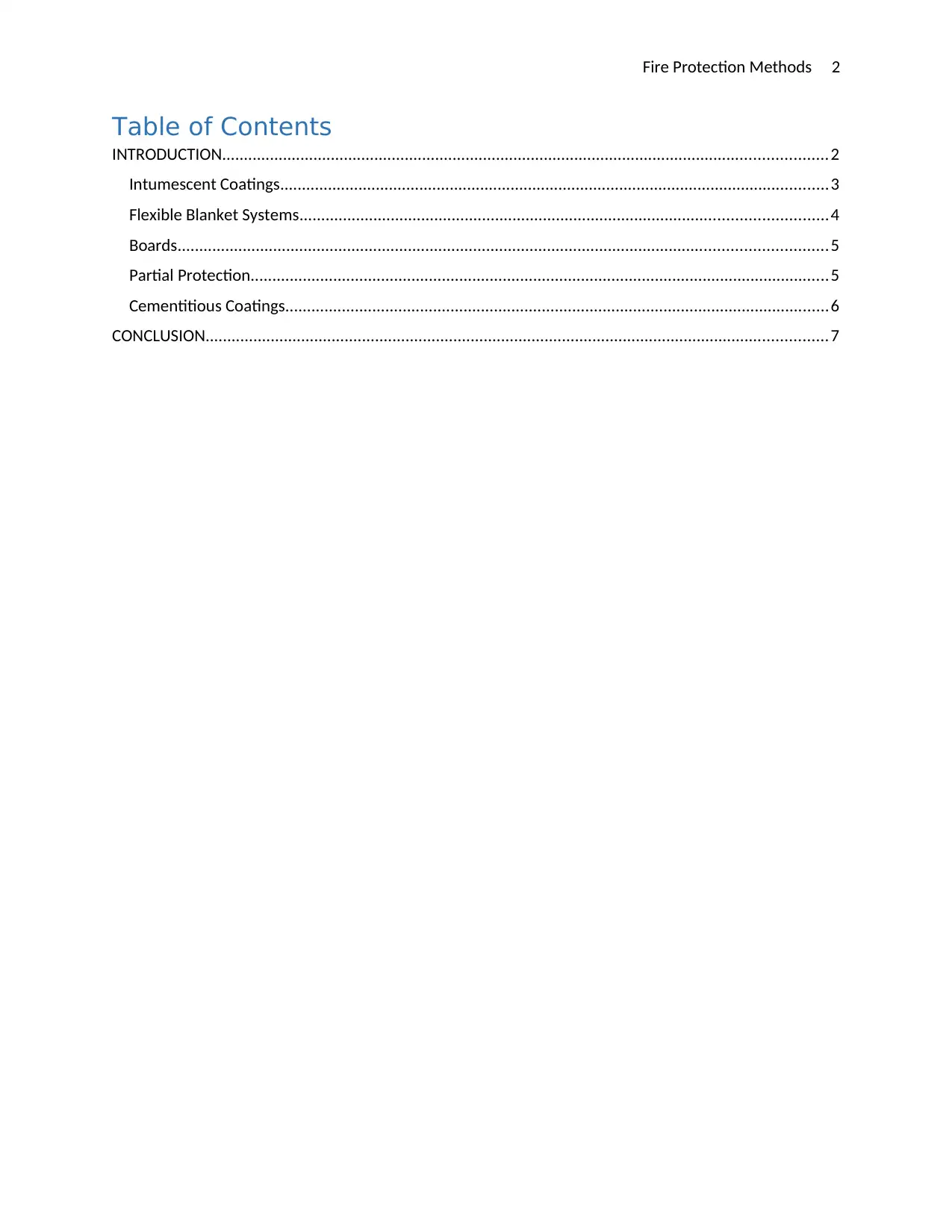
Fire Protection Methods 2
Table of Contents
INTRODUCTION...........................................................................................................................................2
Intumescent Coatings..............................................................................................................................3
Flexible Blanket Systems.........................................................................................................................4
Boards.....................................................................................................................................................5
Partial Protection.....................................................................................................................................5
Cementitious Coatings.............................................................................................................................6
CONCLUSION...............................................................................................................................................7
Table of Contents
INTRODUCTION...........................................................................................................................................2
Intumescent Coatings..............................................................................................................................3
Flexible Blanket Systems.........................................................................................................................4
Boards.....................................................................................................................................................5
Partial Protection.....................................................................................................................................5
Cementitious Coatings.............................................................................................................................6
CONCLUSION...............................................................................................................................................7
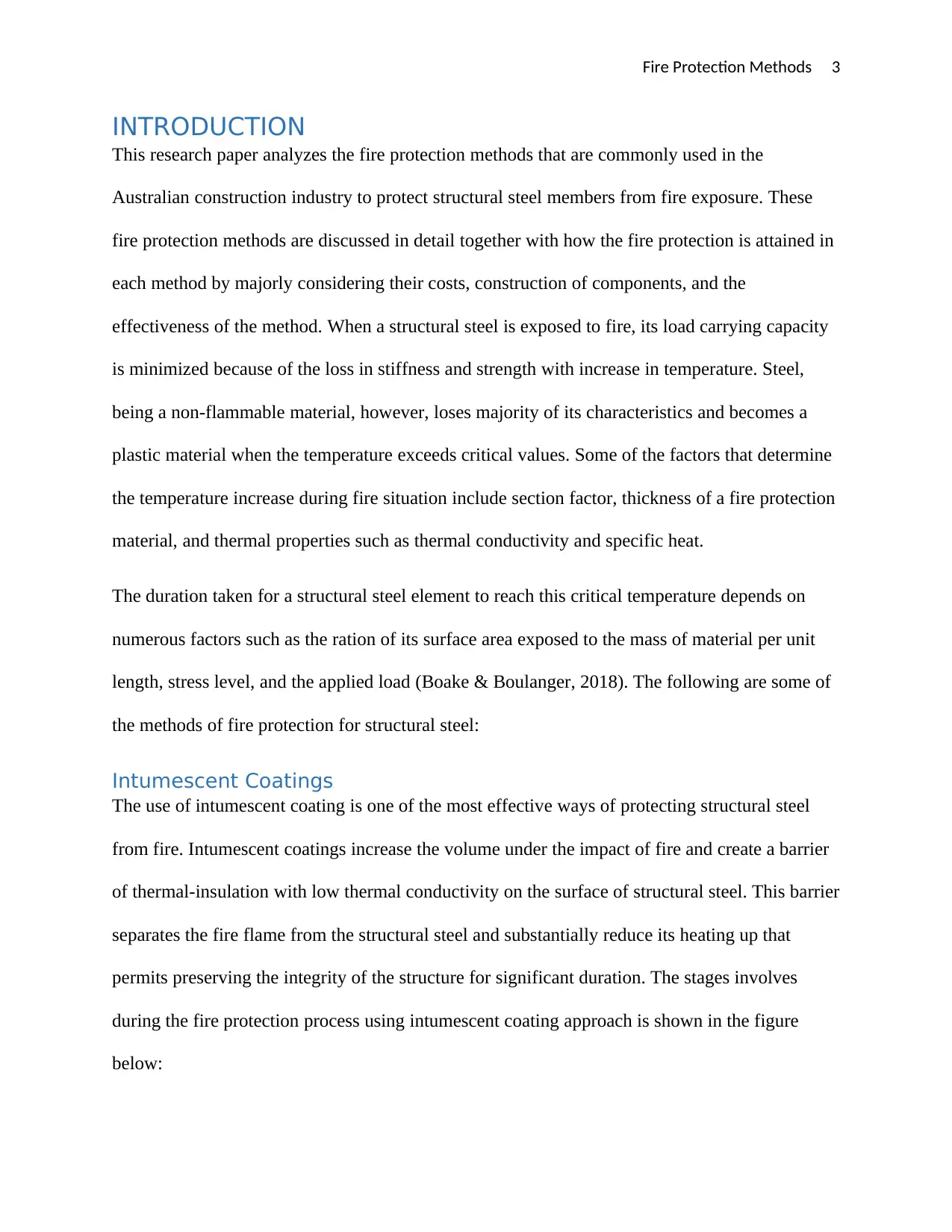
Fire Protection Methods 3
INTRODUCTION
This research paper analyzes the fire protection methods that are commonly used in the
Australian construction industry to protect structural steel members from fire exposure. These
fire protection methods are discussed in detail together with how the fire protection is attained in
each method by majorly considering their costs, construction of components, and the
effectiveness of the method. When a structural steel is exposed to fire, its load carrying capacity
is minimized because of the loss in stiffness and strength with increase in temperature. Steel,
being a non-flammable material, however, loses majority of its characteristics and becomes a
plastic material when the temperature exceeds critical values. Some of the factors that determine
the temperature increase during fire situation include section factor, thickness of a fire protection
material, and thermal properties such as thermal conductivity and specific heat.
The duration taken for a structural steel element to reach this critical temperature depends on
numerous factors such as the ration of its surface area exposed to the mass of material per unit
length, stress level, and the applied load (Boake & Boulanger, 2018). The following are some of
the methods of fire protection for structural steel:
Intumescent Coatings
The use of intumescent coating is one of the most effective ways of protecting structural steel
from fire. Intumescent coatings increase the volume under the impact of fire and create a barrier
of thermal-insulation with low thermal conductivity on the surface of structural steel. This barrier
separates the fire flame from the structural steel and substantially reduce its heating up that
permits preserving the integrity of the structure for significant duration. The stages involves
during the fire protection process using intumescent coating approach is shown in the figure
below:
INTRODUCTION
This research paper analyzes the fire protection methods that are commonly used in the
Australian construction industry to protect structural steel members from fire exposure. These
fire protection methods are discussed in detail together with how the fire protection is attained in
each method by majorly considering their costs, construction of components, and the
effectiveness of the method. When a structural steel is exposed to fire, its load carrying capacity
is minimized because of the loss in stiffness and strength with increase in temperature. Steel,
being a non-flammable material, however, loses majority of its characteristics and becomes a
plastic material when the temperature exceeds critical values. Some of the factors that determine
the temperature increase during fire situation include section factor, thickness of a fire protection
material, and thermal properties such as thermal conductivity and specific heat.
The duration taken for a structural steel element to reach this critical temperature depends on
numerous factors such as the ration of its surface area exposed to the mass of material per unit
length, stress level, and the applied load (Boake & Boulanger, 2018). The following are some of
the methods of fire protection for structural steel:
Intumescent Coatings
The use of intumescent coating is one of the most effective ways of protecting structural steel
from fire. Intumescent coatings increase the volume under the impact of fire and create a barrier
of thermal-insulation with low thermal conductivity on the surface of structural steel. This barrier
separates the fire flame from the structural steel and substantially reduce its heating up that
permits preserving the integrity of the structure for significant duration. The stages involves
during the fire protection process using intumescent coating approach is shown in the figure
below:
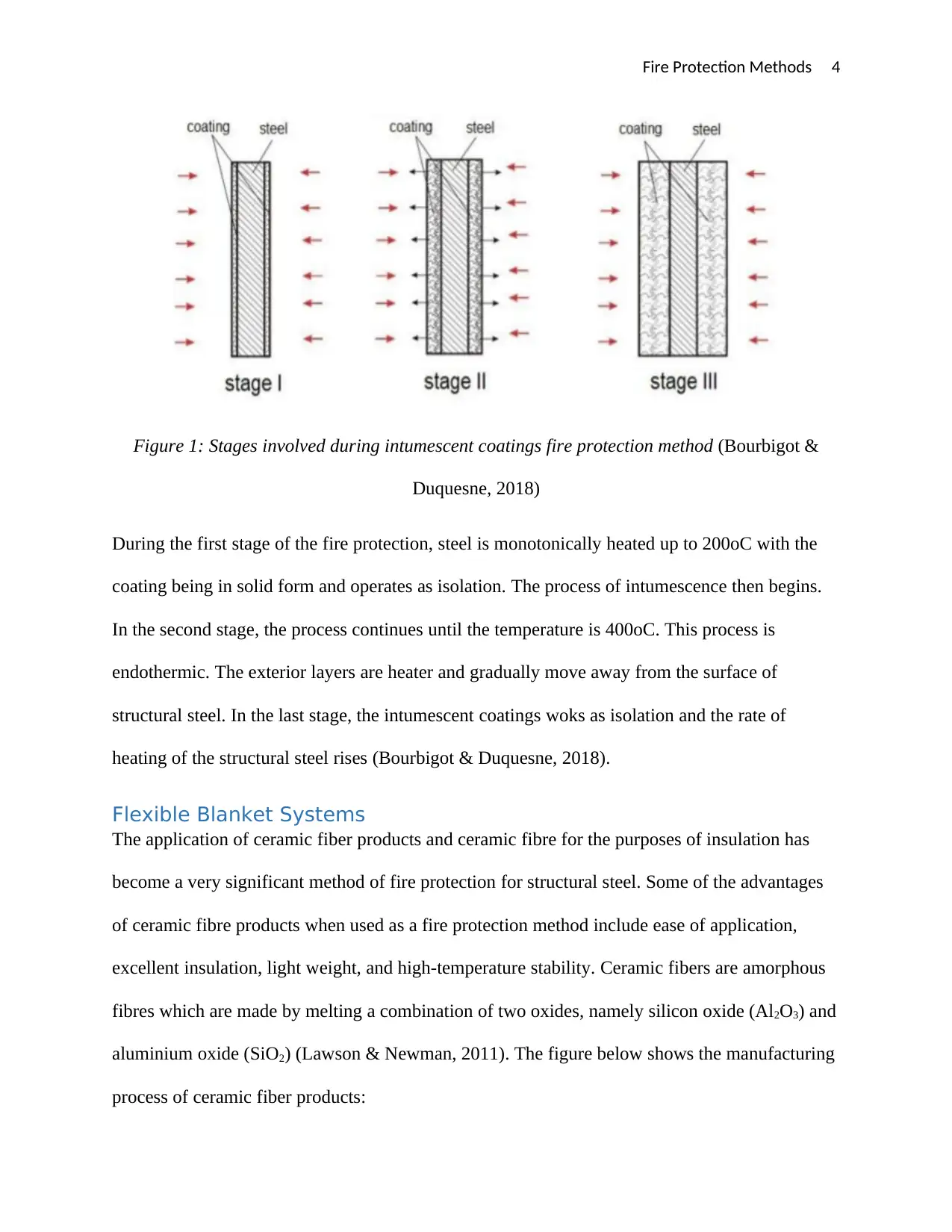
Fire Protection Methods 4
Figure 1: Stages involved during intumescent coatings fire protection method (Bourbigot &
Duquesne, 2018)
During the first stage of the fire protection, steel is monotonically heated up to 200oC with the
coating being in solid form and operates as isolation. The process of intumescence then begins.
In the second stage, the process continues until the temperature is 400oC. This process is
endothermic. The exterior layers are heater and gradually move away from the surface of
structural steel. In the last stage, the intumescent coatings woks as isolation and the rate of
heating of the structural steel rises (Bourbigot & Duquesne, 2018).
Flexible Blanket Systems
The application of ceramic fiber products and ceramic fibre for the purposes of insulation has
become a very significant method of fire protection for structural steel. Some of the advantages
of ceramic fibre products when used as a fire protection method include ease of application,
excellent insulation, light weight, and high-temperature stability. Ceramic fibers are amorphous
fibres which are made by melting a combination of two oxides, namely silicon oxide (Al2O3) and
aluminium oxide (SiO2) (Lawson & Newman, 2011). The figure below shows the manufacturing
process of ceramic fiber products:
Figure 1: Stages involved during intumescent coatings fire protection method (Bourbigot &
Duquesne, 2018)
During the first stage of the fire protection, steel is monotonically heated up to 200oC with the
coating being in solid form and operates as isolation. The process of intumescence then begins.
In the second stage, the process continues until the temperature is 400oC. This process is
endothermic. The exterior layers are heater and gradually move away from the surface of
structural steel. In the last stage, the intumescent coatings woks as isolation and the rate of
heating of the structural steel rises (Bourbigot & Duquesne, 2018).
Flexible Blanket Systems
The application of ceramic fiber products and ceramic fibre for the purposes of insulation has
become a very significant method of fire protection for structural steel. Some of the advantages
of ceramic fibre products when used as a fire protection method include ease of application,
excellent insulation, light weight, and high-temperature stability. Ceramic fibers are amorphous
fibres which are made by melting a combination of two oxides, namely silicon oxide (Al2O3) and
aluminium oxide (SiO2) (Lawson & Newman, 2011). The figure below shows the manufacturing
process of ceramic fiber products:
Secure Best Marks with AI Grader
Need help grading? Try our AI Grader for instant feedback on your assignments.
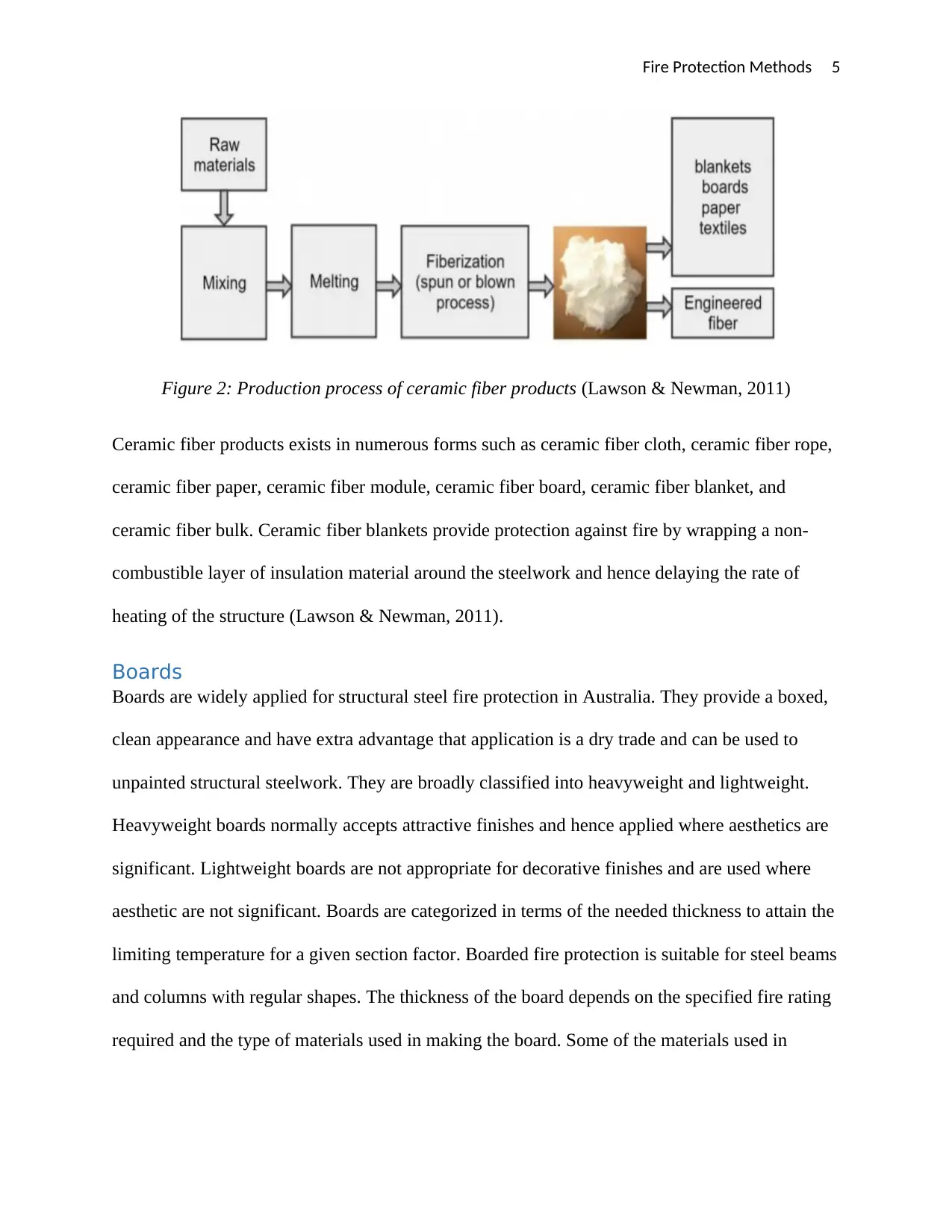
Fire Protection Methods 5
Figure 2: Production process of ceramic fiber products (Lawson & Newman, 2011)
Ceramic fiber products exists in numerous forms such as ceramic fiber cloth, ceramic fiber rope,
ceramic fiber paper, ceramic fiber module, ceramic fiber board, ceramic fiber blanket, and
ceramic fiber bulk. Ceramic fiber blankets provide protection against fire by wrapping a non-
combustible layer of insulation material around the steelwork and hence delaying the rate of
heating of the structure (Lawson & Newman, 2011).
Boards
Boards are widely applied for structural steel fire protection in Australia. They provide a boxed,
clean appearance and have extra advantage that application is a dry trade and can be used to
unpainted structural steelwork. They are broadly classified into heavyweight and lightweight.
Heavyweight boards normally accepts attractive finishes and hence applied where aesthetics are
significant. Lightweight boards are not appropriate for decorative finishes and are used where
aesthetic are not significant. Boards are categorized in terms of the needed thickness to attain the
limiting temperature for a given section factor. Boarded fire protection is suitable for steel beams
and columns with regular shapes. The thickness of the board depends on the specified fire rating
required and the type of materials used in making the board. Some of the materials used in
Figure 2: Production process of ceramic fiber products (Lawson & Newman, 2011)
Ceramic fiber products exists in numerous forms such as ceramic fiber cloth, ceramic fiber rope,
ceramic fiber paper, ceramic fiber module, ceramic fiber board, ceramic fiber blanket, and
ceramic fiber bulk. Ceramic fiber blankets provide protection against fire by wrapping a non-
combustible layer of insulation material around the steelwork and hence delaying the rate of
heating of the structure (Lawson & Newman, 2011).
Boards
Boards are widely applied for structural steel fire protection in Australia. They provide a boxed,
clean appearance and have extra advantage that application is a dry trade and can be used to
unpainted structural steelwork. They are broadly classified into heavyweight and lightweight.
Heavyweight boards normally accepts attractive finishes and hence applied where aesthetics are
significant. Lightweight boards are not appropriate for decorative finishes and are used where
aesthetic are not significant. Boards are categorized in terms of the needed thickness to attain the
limiting temperature for a given section factor. Boarded fire protection is suitable for steel beams
and columns with regular shapes. The thickness of the board depends on the specified fire rating
required and the type of materials used in making the board. Some of the materials used in
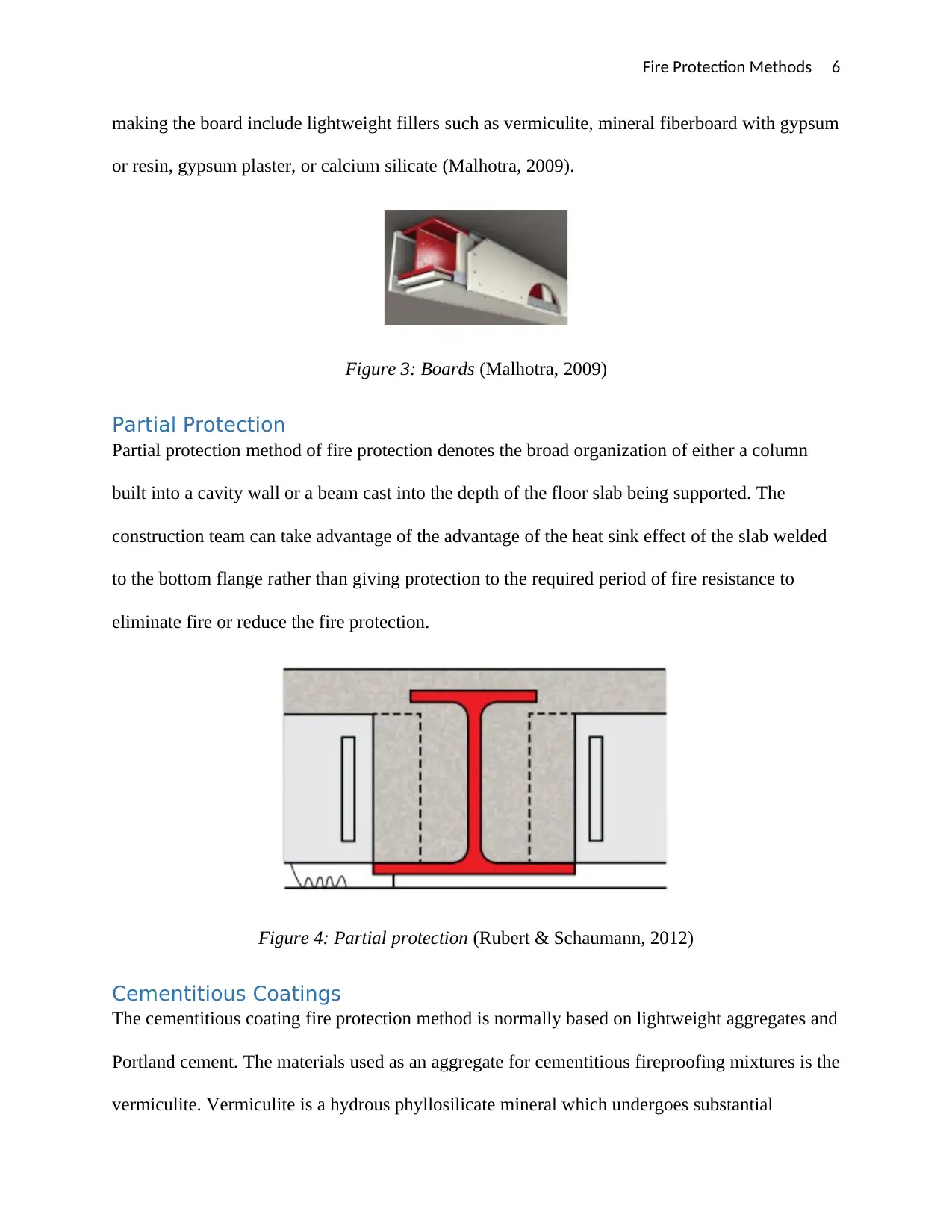
Fire Protection Methods 6
making the board include lightweight fillers such as vermiculite, mineral fiberboard with gypsum
or resin, gypsum plaster, or calcium silicate (Malhotra, 2009).
Figure 3: Boards (Malhotra, 2009)
Partial Protection
Partial protection method of fire protection denotes the broad organization of either a column
built into a cavity wall or a beam cast into the depth of the floor slab being supported. The
construction team can take advantage of the advantage of the heat sink effect of the slab welded
to the bottom flange rather than giving protection to the required period of fire resistance to
eliminate fire or reduce the fire protection.
Figure 4: Partial protection (Rubert & Schaumann, 2012)
Cementitious Coatings
The cementitious coating fire protection method is normally based on lightweight aggregates and
Portland cement. The materials used as an aggregate for cementitious fireproofing mixtures is the
vermiculite. Vermiculite is a hydrous phyllosilicate mineral which undergoes substantial
making the board include lightweight fillers such as vermiculite, mineral fiberboard with gypsum
or resin, gypsum plaster, or calcium silicate (Malhotra, 2009).
Figure 3: Boards (Malhotra, 2009)
Partial Protection
Partial protection method of fire protection denotes the broad organization of either a column
built into a cavity wall or a beam cast into the depth of the floor slab being supported. The
construction team can take advantage of the advantage of the heat sink effect of the slab welded
to the bottom flange rather than giving protection to the required period of fire resistance to
eliminate fire or reduce the fire protection.
Figure 4: Partial protection (Rubert & Schaumann, 2012)
Cementitious Coatings
The cementitious coating fire protection method is normally based on lightweight aggregates and
Portland cement. The materials used as an aggregate for cementitious fireproofing mixtures is the
vermiculite. Vermiculite is a hydrous phyllosilicate mineral which undergoes substantial
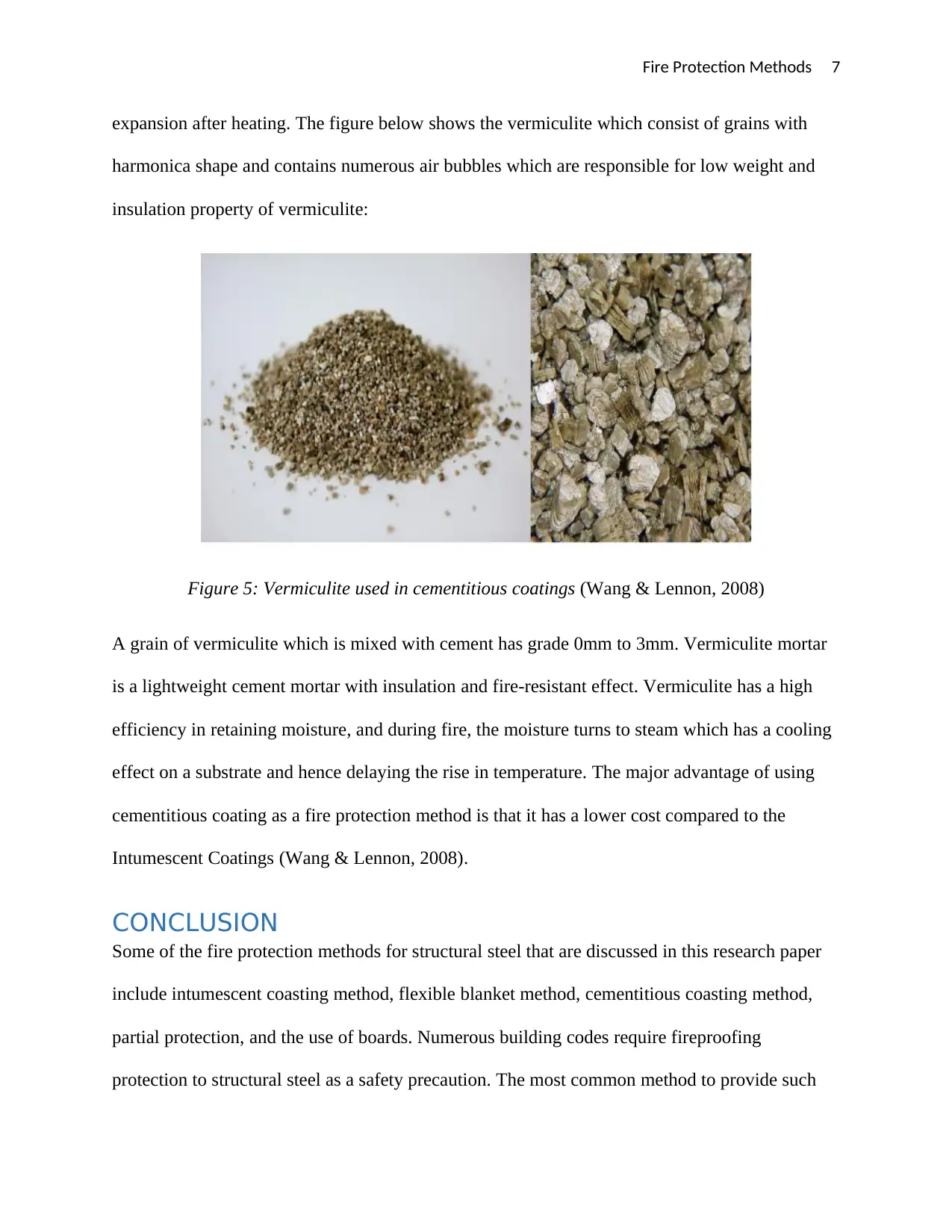
Fire Protection Methods 7
expansion after heating. The figure below shows the vermiculite which consist of grains with
harmonica shape and contains numerous air bubbles which are responsible for low weight and
insulation property of vermiculite:
Figure 5: Vermiculite used in cementitious coatings (Wang & Lennon, 2008)
A grain of vermiculite which is mixed with cement has grade 0mm to 3mm. Vermiculite mortar
is a lightweight cement mortar with insulation and fire-resistant effect. Vermiculite has a high
efficiency in retaining moisture, and during fire, the moisture turns to steam which has a cooling
effect on a substrate and hence delaying the rise in temperature. The major advantage of using
cementitious coating as a fire protection method is that it has a lower cost compared to the
Intumescent Coatings (Wang & Lennon, 2008).
CONCLUSION
Some of the fire protection methods for structural steel that are discussed in this research paper
include intumescent coasting method, flexible blanket method, cementitious coasting method,
partial protection, and the use of boards. Numerous building codes require fireproofing
protection to structural steel as a safety precaution. The most common method to provide such
expansion after heating. The figure below shows the vermiculite which consist of grains with
harmonica shape and contains numerous air bubbles which are responsible for low weight and
insulation property of vermiculite:
Figure 5: Vermiculite used in cementitious coatings (Wang & Lennon, 2008)
A grain of vermiculite which is mixed with cement has grade 0mm to 3mm. Vermiculite mortar
is a lightweight cement mortar with insulation and fire-resistant effect. Vermiculite has a high
efficiency in retaining moisture, and during fire, the moisture turns to steam which has a cooling
effect on a substrate and hence delaying the rise in temperature. The major advantage of using
cementitious coating as a fire protection method is that it has a lower cost compared to the
Intumescent Coatings (Wang & Lennon, 2008).
CONCLUSION
Some of the fire protection methods for structural steel that are discussed in this research paper
include intumescent coasting method, flexible blanket method, cementitious coasting method,
partial protection, and the use of boards. Numerous building codes require fireproofing
protection to structural steel as a safety precaution. The most common method to provide such
Paraphrase This Document
Need a fresh take? Get an instant paraphrase of this document with our AI Paraphraser
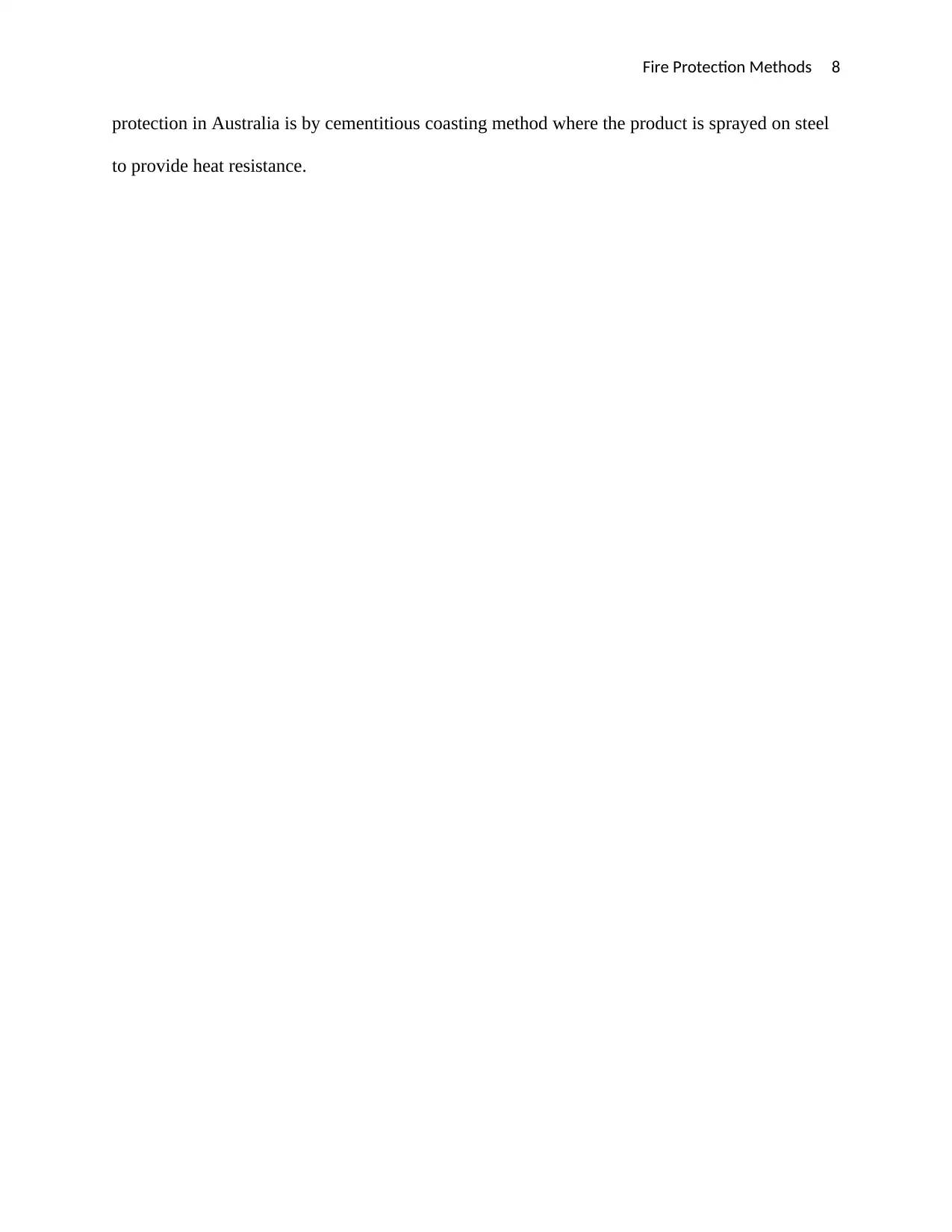
Fire Protection Methods 8
protection in Australia is by cementitious coasting method where the product is sprayed on steel
to provide heat resistance.
protection in Australia is by cementitious coasting method where the product is sprayed on steel
to provide heat resistance.
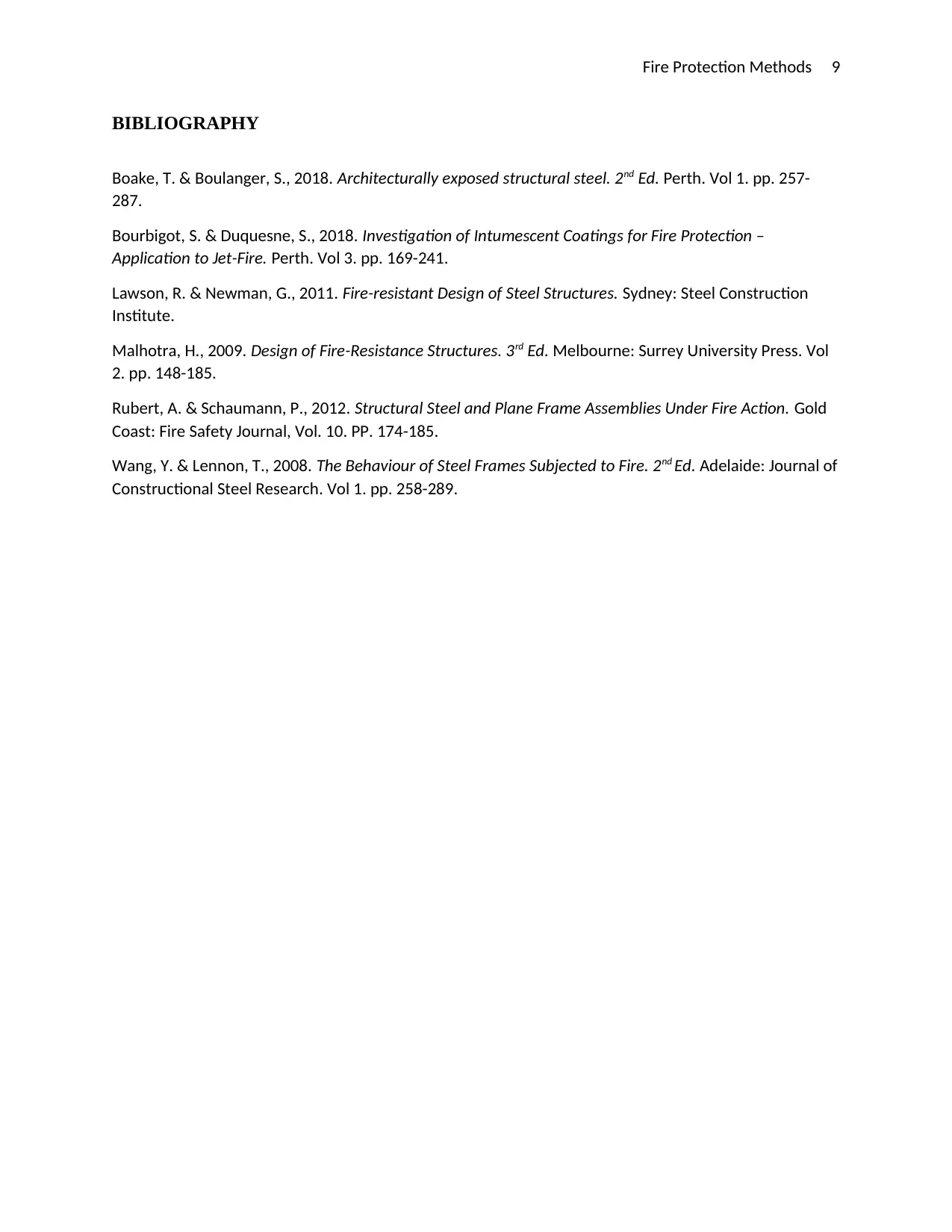
Fire Protection Methods 9
BIBLIOGRAPHY
Boake, T. & Boulanger, S., 2018. Architecturally exposed structural steel. 2nd Ed. Perth. Vol 1. pp. 257-
287.
Bourbigot, S. & Duquesne, S., 2018. Investigation of Intumescent Coatings for Fire Protection –
Application to Jet-Fire. Perth. Vol 3. pp. 169-241.
Lawson, R. & Newman, G., 2011. Fire-resistant Design of Steel Structures. Sydney: Steel Construction
Institute.
Malhotra, H., 2009. Design of Fire-Resistance Structures. 3rd Ed. Melbourne: Surrey University Press. Vol
2. pp. 148-185.
Rubert, A. & Schaumann, P., 2012. Structural Steel and Plane Frame Assemblies Under Fire Action. Gold
Coast: Fire Safety Journal, Vol. 10. PP. 174-185.
Wang, Y. & Lennon, T., 2008. The Behaviour of Steel Frames Subjected to Fire. 2nd Ed. Adelaide: Journal of
Constructional Steel Research. Vol 1. pp. 258-289.
BIBLIOGRAPHY
Boake, T. & Boulanger, S., 2018. Architecturally exposed structural steel. 2nd Ed. Perth. Vol 1. pp. 257-
287.
Bourbigot, S. & Duquesne, S., 2018. Investigation of Intumescent Coatings for Fire Protection –
Application to Jet-Fire. Perth. Vol 3. pp. 169-241.
Lawson, R. & Newman, G., 2011. Fire-resistant Design of Steel Structures. Sydney: Steel Construction
Institute.
Malhotra, H., 2009. Design of Fire-Resistance Structures. 3rd Ed. Melbourne: Surrey University Press. Vol
2. pp. 148-185.
Rubert, A. & Schaumann, P., 2012. Structural Steel and Plane Frame Assemblies Under Fire Action. Gold
Coast: Fire Safety Journal, Vol. 10. PP. 174-185.
Wang, Y. & Lennon, T., 2008. The Behaviour of Steel Frames Subjected to Fire. 2nd Ed. Adelaide: Journal of
Constructional Steel Research. Vol 1. pp. 258-289.
1 out of 9
Related Documents
Your All-in-One AI-Powered Toolkit for Academic Success.
+13062052269
info@desklib.com
Available 24*7 on WhatsApp / Email
![[object Object]](/_next/static/media/star-bottom.7253800d.svg)
Unlock your academic potential
© 2024 | Zucol Services PVT LTD | All rights reserved.



